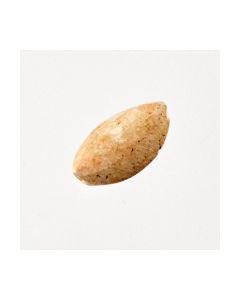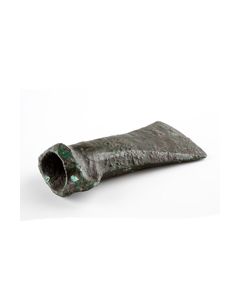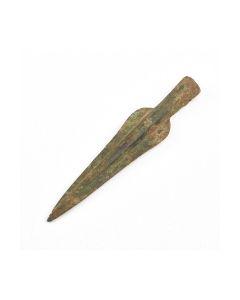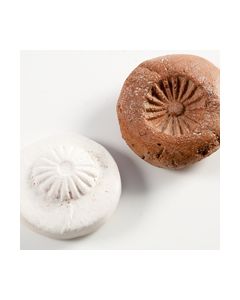Search results for: 'Mitte'
-
 Scarab with magic spell
Scarab with magic spellThe hieroglyphs are of the so called anra design, a magic spell in the ancient Egyptian belief. The scarab is from the 13th to 15th dynasty. It is described in the catalogue of Gautier-Vodoz.
Price: on request Scarab with geometric motive
Scarab with geometric motiveThe motive exhibits two symmetry axes and at least six triangles. A wonderful artistic expression of the highly evolved Egyptian maths. This scarab is described in the catalogue of Irène Gautier-Vodoz.
Price: on request Scarab with lion
Scarab with lionThe scene shows a walking lion. It is framed by an oval cord. This scarab is described in the catalogue of Irène Gautier-Vodoz.
Price: on request Cowroid with magic spell
Cowroid with magic spellThe hieroglyphs of the anra type are to be interpreted as magical formula. From the Second Intermediate Period of ancient Egpyt. This scaraboid is described in the catalogue of Gautier-Vodoz.
Price: on request Tüllenbeil - Fundort Orvieto, Italien
Tüllenbeil - Fundort Orvieto, ItalienItalisches Tüllenbeil mit breiter Schneide. Späte Bronzezeit Italiens. Vollständig intakt mit wunderschöner dunkler Patina.
Price: on request Massive Bronze Age spear head
Massive Bronze Age spear headPerfectly preserved, large piece with beautiful patina. From an old German collection.
Price: on request Scarab with magic formula
Scarab with magic formulaThe stamp shows the anra formula in a cartouche. The amulet should thus serve a magic or ritual purpose for its owner.
Price: on request Scarab with falcon headed god
Scarab with falcon headed godInteresting scarab amulet from the Second Intermediate Period. The seal shows a falcon headed creature facing an Egyptian cobra. This scarab can be found in the catalogue of Irène Gautier-Vodoz.
Price: on request Scarab with pattern of circles
Scarab with pattern of circlesThe beetle stone bears a popular motive of the Middle Empire. A nice example of its kind. This scarab is described in the catalogue of Irène Gautier-Vodoz.
Price: on request Scarab with protective formula
Scarab with protective formulaAmulet for protection. Stilized lotus flowers on the upper side. Magic formula on the lower side. This scarab is described in the catalogue of Irène Gautier-Vodoz.
Price: on request Cowroid with decorated body
Cowroid with decorated bodyThe cowroid has an interesting decoration across the upper surface. The lower surface is inscribed with hieroglyphs. This cowroid is discussed in the catalogue of Gautier-Vodoz.
Price: on request Massive Bronze Age spear head
Massive Bronze Age spear headPerfectly preserved, large piece with beautiful patina. From an old German collection.
Price: on request Massive Bronze Age spear head
Massive Bronze Age spear headPerfectly preserved, large piece with beautiful patina. From an old German collection.
Price: on request Massive Bronze Age spear head
Massive Bronze Age spear headPerfectly preserved, large piece with beautiful patina. From an old German collection.
Price: on request Scarab with breath of life
Scarab with breath of lifeThe Ankh on the bottom side of this ancient egyptian scarab symbolized life or afterlife. The symbol is framed by volutes.
Price: on request Egyptian amulet mould from the Amarna period
Egyptian amulet mould from the Amarna periodGussform aus Terrakotta, für ein Amulett in Form eines Blütenblatts. 18. bis 19. Dynastie, 1600 v. Chr. bis 1100 v. Chr., Altes Ägypten.
Price: on request Egyptian amulet mould from the Amarna period
Egyptian amulet mould from the Amarna periodGussform aus Terrakotta, für ein Amulett in Form eines Blütenblatts. 18. bis 19. Dynastie, 1600 v. Chr. bis 1100 v. Chr., Altes Ägypten.
Price: on request Sichel aus der Bronzezeit
Sichel aus der BronzezeitBronzezeitliche Knopfsichel mit fließend geformtem Sichelrund und einer flach-konkaven Klinge. 2. Hälfte des 2. Jt. v. Chr., Europa. 100mm lang.
Price: on request Ägyptische Gussform aus der Amarna-Zeit
Ägyptische Gussform aus der Amarna-ZeitGussform aus Terrakotta, für ein Amulett in Form eines Blütenblatts. 18. bis 19. Dynastie, 1600 v. Chr. bis 1100 v. Chr., Altes Ägypten.
Price: on request Scarab with sphinx
Scarab with sphinxThe stamp depicts a sphinx with pharaoh headcloth walking towards the Ankh symbol of life. The amulet should exert a protective function on the one carrying or owning it.
Price: on request Ägyptischer Skarabäus
Ägyptischer SkarabäusPreiswertes Skarabäussiegel mit leichtem Schaden. Dekoratives Siegel schön erhalten mit geometrischem Motiv. Reste von Fayence. 12. bis 18. Dynastie. 17mm lang.
Price: on request Lorestanischer Keramikkrug
Lorestanischer KeramikkrugGroße Keramik aus Lorestan. Einhenkliger Krug von eleganter Form. Über 20cm hoch. 1500 bis 500 v. Chr., Späte Bronzezeit bis Eisenzeit.
Price: on request Akkadian cylinder seal of shell core
Akkadian cylinder seal of shell coreTwo lions are fighting with two buffalos. The balance and detail of the scene is an impressive demonstration of the Akkadian seal engraver's skill. Old Akkadian, around 2300 BC.
Price: on request Lorestanische Keramikamphore
Lorestanische KeramikamphoreGroße Keramik aus Lorestan. Amphore mit Ritzdekor. 18,5cm hoch. 2000 bis 500 v. Chr., Mittlere Bronzezeit bis Eisenzeit.
Price: on request Faience tile of the Djoser pyramid type
Faience tile of the Djoser pyramid typeEgyptian wall tile from the Old Kingdom, 2nd to 3rd dynasty. The tile type is known from the famous step pyramid of king Djoser.
Price: on request Ägyptischer Skarabäus aus blauer Fayence
Ägyptischer Skarabäus aus blauer FayenceCa 1000 v.Chr., 21. Dynastie, Dritte Zwischenzeit. Der Stempel zeigt ein Muster aus 10 Kreisen, Ober- und Unterseite vollständig und museal erhalten.
Price: on request Bronze Age axe head
Bronze Age axe headVery well preserved axe head. Late Bronze Age, 10th to 9th cent. BC.
Price: on request Bronze Age axe head
Bronze Age axe headVery well preserved axe head. Late Bronze Age, 10th to 9th cent. BC.
Price: on request Bronze Age axe head
Bronze Age axe headVery well preserved axe head. Late Bronze Age, 10th to 9th cent. BC.
Price: on request Speerspitze aus Lorestan
Speerspitze aus LorestanGroße luristanische Speerspitze mit Spuren von Kampfeinsatz. 2500 bis 1000 v. Chr., 185mm lang. Zeugnis der eigenständigen Kultur in der persischen Provinz Luristan.
Price: on request Elamite cylinder seal for Aham-Lurshi
Elamite cylinder seal for Aham-LurshiEngraved in fine detail and well preserved. Scene with three gods. Three columns of cuneiform inscription name the owner Aham-Lurshi. Approx. 1900 to 1600 BC.
Price: on request Uschepti der 21. Dynastie
Uschepti der 21. DynastieÄgyptische Totenfigur der 3. Zwischenzeit. Schöne türkise Fayence. Aufgemalte Hieroglyphen, Stirnband und Korb. Eindrucksvoller Uschepti.
Price: on request

